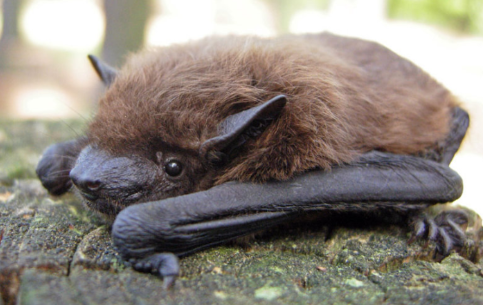Evening Bat: Nycticeius Humeralis

This bat’s name, Evening Bat, refers to its usual time of foraging, which is the last half hour before daylight. Typically, they fly slowly and high in the evening (40 to 75 feet) before descending at night to a lower flight.
The evening bat is tiny with thick dark brown fur, black ears, a muzzle, a wing, and a tail membrane. On the back, when parted, the fur’s color shows black bases and dark brown external portions. The under sections tend to be paler in color and more buff. They have thick, rounded, nearly naked ears; the tragus (inside ear protruding out) is short, round, and slightly forward-curved.1Go To Source tn.gov -“Evening Bat”
Learn More: U.S. Bat Species
Habitat Of The Evening Bat
The evening bat is a forest-dwelling bat species that roosts in buildings, inside tree crevices, and behind loose bark. This species seldom enters caves but sometimes roosts near cave entrances in late summer. Historically, tree hollows were the favorite roosting location, but many have moved into wooden buildings as forests have been cut down.
This species prefers to forage in clearings and over waterways along the edges of mature forests. Since most of the evening bat diet consists of insects, they will migrate to areas with a high density of insects.
Evening Bat Range
The evening bat is found in most eastern deciduous forests. This species has been spotted in areas from eastern Nebraska through East Texas, and in northern Mexico.
The evening bat lives at altitudes from sea level to 300 m. 2Go To Source tpwd.texas.gov -“Evening Bat”
Evening Bat Diet
Evening bats, mostly feeding on flies, beetles, flying ants, stink bugs, moths, and grasshoppers, are insectivorous. Echolocation is used to find food since bats have poor eyesight.
Foraging occurs in the early evening, along forest edges, over waterways and clearings, just before dawn.3Go To Source columbusbatcontrol.com -“Evening Bat”
Behavior Of The Evening Bat
As they are nocturnal animals, the Evening bats forage at night. They are known to have slow but steady flight patterns, unlike other quick-flight bats.
Very early in the morning and evening, they usually fly high, but lower when flying at night. They are highly social animals, and they always live in colonies of around 30 animals.
Evening Bat Reproduction Cycle

In the late summer and early fall, mating takes place. Sperm is stored in the female’s reproductive tract until spring when there are ovulation and fertilization periods. Evening bats have a harem-like association of around twenty females with one male. Young bats are born in nursery colonies, usually in hollow trees, behind loose bark, and sometimes in buildings’ attics. Females usually give birth to twins, but it’s known that some females produce triplets and raise them successfully.
The pups weigh 2g at birth and represent 50 percent of the mother’s body mass. The pups are pink and hairless when born but are capable of communication via squeaking. The pups will not open their eyes until 24-30 hours after birth, and until they are about three weeks old, bats don’t fly.
They can navigate turns (gliding) and land on walls and ceilings at the end of three weeks. 6 to 9 weeks after birth, the pups are weaned. After six weeks, the male pups exit the roost, but the females remain in the colony. This is because in the year following their birth, new bats breed. 4Go To Source animaldiversity.org -“Nycticeius humeralis evening bat”
Conservation Of Evening Bats
While the evening bat has adapted to the changes that humans have brought to the landscape, the conversion of forests to agricultural use is likely to have led to a significant reduction in the habitat of prime roosting and foraging.
Logging operations in some forests have also resulted in the loss of prime roosting trees for bats. 5Go To Source biology.eku.edu -“Evening Bat (Nycticeius Humeralis)”
Sources:
- “Evening Bat | Tennessee Wildlife Resources Agency.” Tennessee Wildlife Resources Agency, www.tn.gov/twra/wildlife/mammals/mammals-bats/evening-bat.html. Accessed 9 Dec. 2020.
- “Evening Bat (Nycticeius Humeralis).” Texas Parks & Wildlife, tpwd.texas.gov/huntwild/wild/species/evening. Accessed 9 Dec. 2020.
- Neely, M. 2003. “Nycticeius humeralis” (On-line), Animal Diversity Web. Accessed December 09, 2020 at https://animaldiversity.org/accounts/Nycticeius_humeralis/
- “Evening Bat.” Kentucky Bat Working Group, biology.eku.edu/bats/eveningbat.html. Accessed 9 Dec. 2020.
